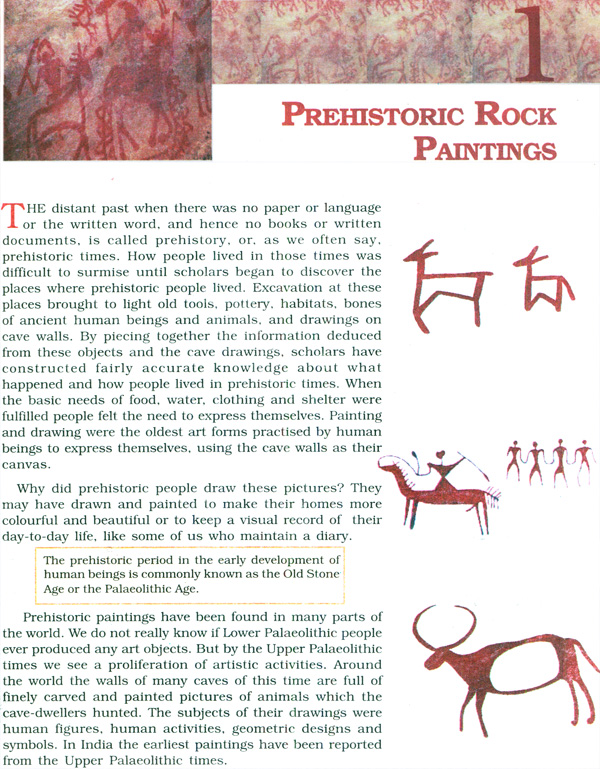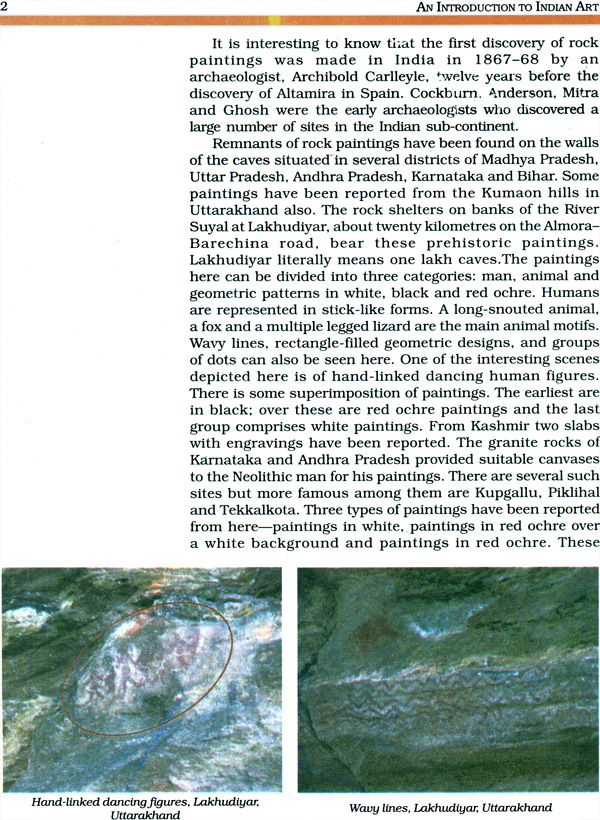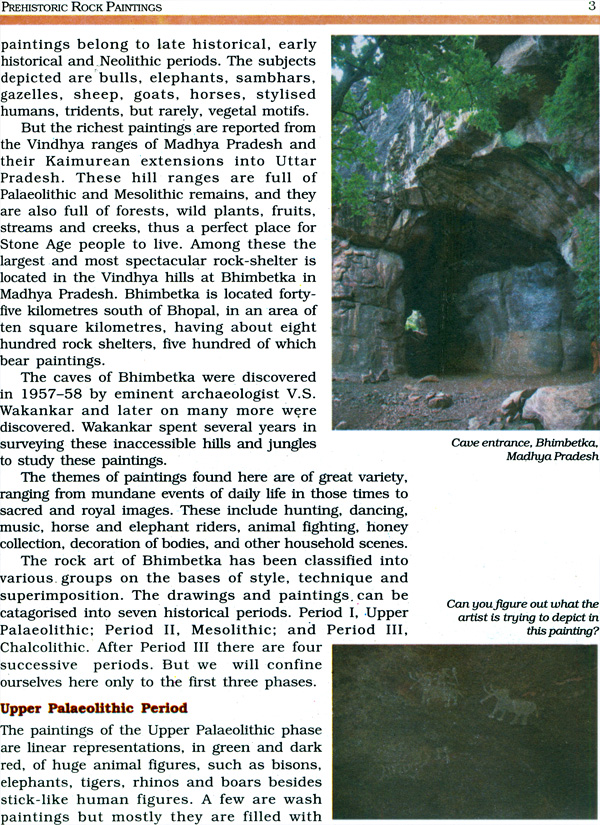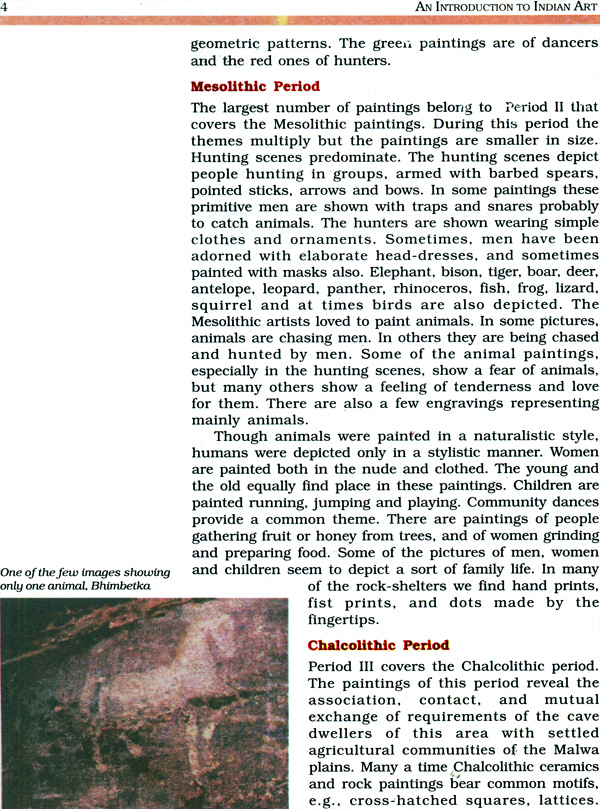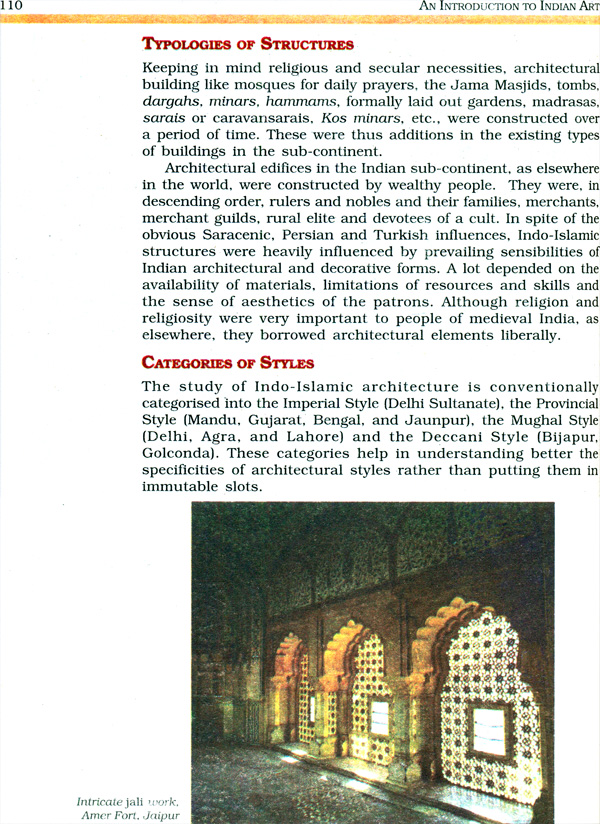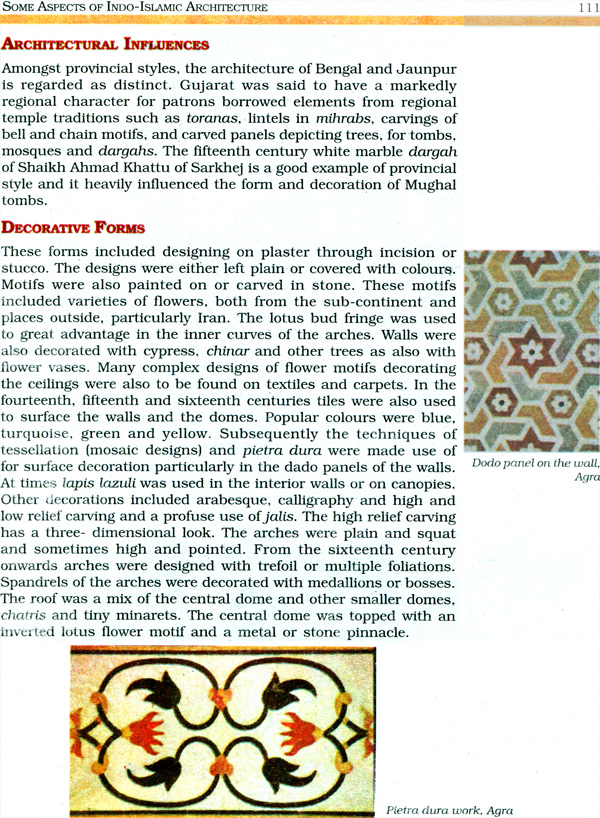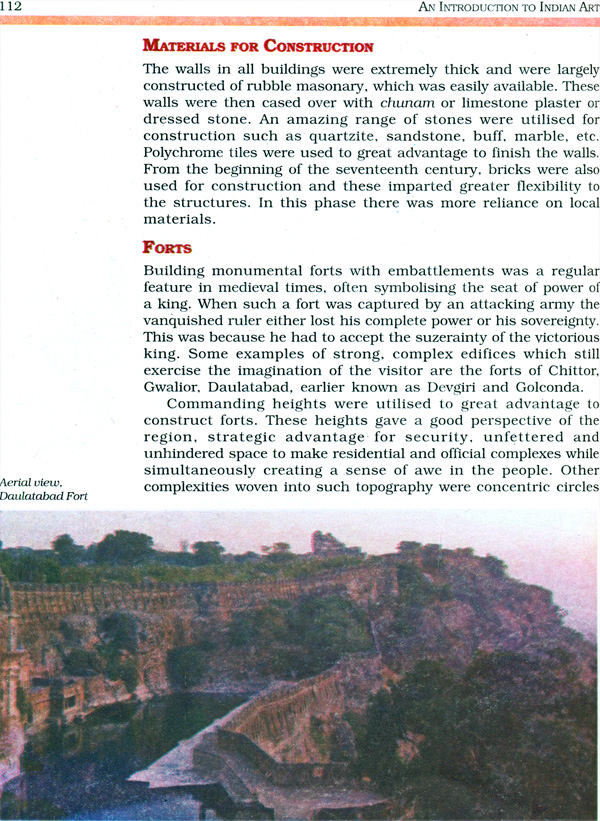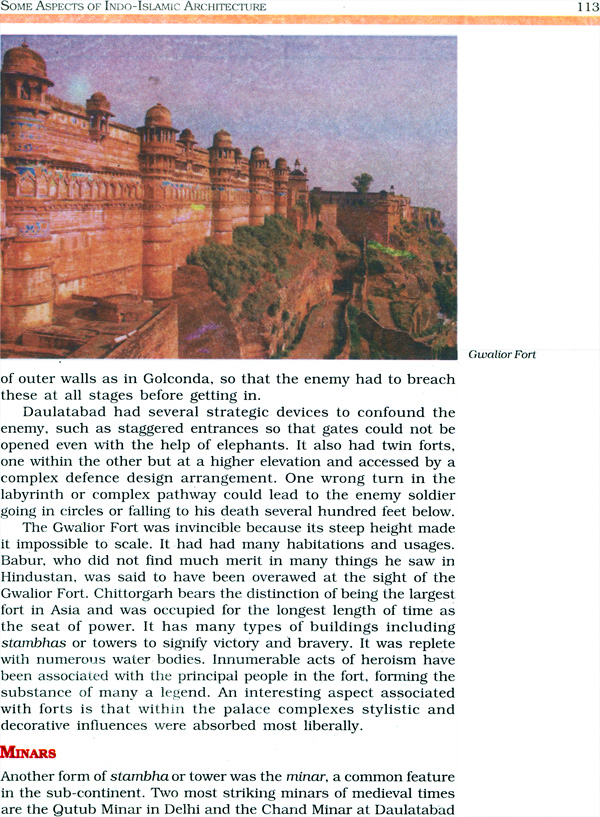
An Introduction to Indian Art (Textbook in Fine Arts for Class XI)
Book Specification
| Item Code: | NAN365 |
| Publisher: | NATIONAL COUNCIL OF EDUCATIONAL RESEARCH |
| Language: | English |
| Edition: | 2015 |
| ISBN: | 9789350071878 |
| Pages: | 142 (Throughout Color and B/W Illustrations) |
| Cover: | Paperback |
| Other Details | 10.5 inch X 8.0 inch |
| Weight | 340 gm |
Book Description
During the nineteenth century (the period of British rule), a few British colonial officers took active interest to study India's past in collaboration with some Indian scholars and it is out of such endeavours that a systematic study of architectural monuments, sculptures and paintings began in the Indian sub-continent. The first attempt in this regard document the monuments as they represent a very visible evidence of the bygone era. Over a period of time with the archaeological explorations and excavations, many art-historical sites were discovered. Decipherment of inscriptions, and coins played a very significant role in our understanding of the past art traditions. With the study of religious texts, history of religion was studied and identification of icons/sculptures and paintings was initiated, which became a dominant area of early scholarship. Study of art history has developed in association with the archaeological studies, however, it is now recognised as a specialised discipline. In the West, mainly in Europe, the art-historical discipline has grown considerably with numerous methodological inputs, whereas in India it is still in the process of developing its investigating mechanisms.
As the study of art history has grown out of extensive documentations and excavations, one finds description of art objects as a prominent method of study. There are a few significant studies of the early twentieth century, where the concerns are addressed beyond mere description. Subsequently, several generations of outstanding Western and Indian scholars of Indian art history have studied the subject at great depth making us realise the glorious past of the Indian civilisation through its creations reflected in the architectural monuments, sculptures and paintings. We can claim a distinct Indian approach to the arts of the building edifices, the sculpture making and the language of painting in comparison with the European art on one hand and the far Eastern art on the other. Therefore, the Indian art historical studies have emerged as a prestigious academic discipline at a university level education.
While political and religious history contributed towards reconstructing historical developments, sculptural and architectural history has been reconstructed within the time-frame of political history. The styles of many monuments and sculptures have been attributed to the dynastic affiliations like the Mauryan art, Satavahana art, Gupta art, etc. Alternatively the periodisations of art follows religious denominations such as the Buddhist, Hindu and Islamic periods. However, such deterministic nomenclatures are only partially useful for understanding the art traditions.
Often the study of art objects is based on two important approaches, (i) formalistic or stylistic analysis and (ii) content and contextual studies. The first category involves study of formalistic characteristics of architecture/sculpture/paintings, whereas the second category concentrates at various levels of content analysis which has several components such as iconographic study, iconology, narrative and semiotics.
Iconography involves identification of images through certain symbols/signs and relevant myths or narrative episodes, whereas iconology Involves study of evolution of such signs and symbols in its historical, social and philosophical context. Today, the methodological framework tries to explore various concerns and issues in the process of art productions and attempts to go beyond the traditional meanings. It may be observed that the political intentions of various religious ideologies are yet to become the part of the larger investigative process. Religious ideologies also were instrumental in shaping the social and economic formulations in ancient India. Therefore, it becomes important to study such factors that have influenced art forms. Large body of material has' come from the religious sites but it does not mean that there was no art in non- religious domains. Terracotta figurines are the best examples in this category, however, due to space constraint they have been only' mentioned but not extensively discussed. In the present text, the authors have tried to move away from the normative traditional descriptive writings' to broader development of art and architectural monuments in terms of their stylistic developments as well as their social and political affiliations.
Cultural manifestations have diverse ideologies in the form of architecture, sculpture and paintings. They need to be studied with their religious and 'social view points, hence, unilinear projection of the cultural tradition needs to be reconsidered as it is away from realities of the ancient past. Different categories of artisans existed in the actual working situation. A guild of artisans may have been employed by the religious and political authorities for making monuments and accordingly the artisans had to work and devise their execution techniques along with necessary innovations, etc. In this textbook only an introductory outline has been attempted from pre- and proto-historic times till the times of the Islamic monuments during the late medieval period.
Considering the level of the young generation readers belonging to the higher secondary stage, the present book outlines just a few examples to create an understanding of the nature of developments in Indian art. It is not intended to discard such examples which we know are important but all the contributors have made a conscious attempt to present convincing holistic pictures. The chapters in the book provide an outline of different forms of arts from most of the regions of the country.
Human civilisation begins with the emergence of the human being on the earth. In this book a simpler but at the same time a distinct vocabulary has been introduced. The idea is not only to present the vast amount of data available but also to generate interest in understanding the visual traditions of Indian art. For any student of fine arts it is necessary to be aware of the visual tradition in the past as to understand present art production. Understanding of visual tradition enriches visual understanding. Hope the young minds find the book enriching as is intended.
The National Council of Educational Research and Training (NCERT) has constantly been working for the past fifty years to bring in an impact on the country's school educational system. In the recent years, specially with the National Curriculum Framework (NCF) - 2005, there has been a significant shift in the development of textbooks, their presentation and inter-disciplinary approach, the typology of exercises, etc. All these efforts have made the textbooks child friendly. At the senior secondary stage, which is also the school leaving stage, students should have more options to move further in different fields of higher education or professional education. With this view, the NCERT for the first time took the initiatives of developing the curriculum and syllabi in different art related areas for this stage.
At this stage of education, the emphasis has been given to a professional approach towards the subject of Fine Arts making it a discipline rather than on creating awareness and knowledge, which was generic in nature till secondary classes. The teaching objectives also shift towards sharpening of skills in fine arts and develop a perspective of design and instead of free expression and doing arts emphasis is on students' expressing themselves in their own style and medium. Also, there has been a need to develop a historical perspective of art in context of the world as well as India. Art History is a part of studies of arts and in itself it is a major area of education from which students learn about their cultural heritage.
It was observed that many of the education boards offer Fine Arts as an optional subject at the senior secondary stage which includes painting, sculpture, applied arts or commercial arts. These were reviewed and a new syllabus was formed. Since this course apart from the practical component include theory which Introduces students to the art historical heritage of country's diverse art and architecture, the textbook 'An Introduction to Indian Art' has been developed for Classes XI and XII.
The textbook for Class XI extensively covers the tradition of cave paintings in the pre-historic era and their continuation in mural paintings of Buddhist era and later on in various parts of the country, Buddhist, Jain and Hindu sculptural and architectural developments. During the Indo-Islamic period and before the Mughal rule, another era dawned upon India, which saw massive constructions in the form of forts and palaces. Different aspects of all these styles have been discussed to introduce students with the fabric of India's culture.
The NCERT appreciates the hard work done by the Textbook Development Committee responsible for making this book. We wish to thank the Chief Advisor for this textbook, Professor Ratan Parimoo, Retired Head, Department of Art History and Dean, Faculty of Fine Arts, M. S. University of Baroda, for guiding the work of this committee. It was a challenge for other art historians involved in making of this textbook for students at the school level and their efforts are praiseworthy. We are indebted to the institutions and organisations which have generously permitted us to draw upon their resource materials and personnel. We are especially grateful to the members of the National Monitoring Committee, appointed by the Department of Secondary and Higher Education, Ministry of Human Resource Development under the Chairpersonship of Professor Mrinal Miri and Professor G.P. Deshpande, for their valuable time and contribution. As an organisation committed to the systemic reform and continuous improvement in the quality of its products, NCERT welcomes comments and suggestions which will enable us to undertake further revision and refinement.
| Foreword | iii | |
| Preface | v | |
| 1 | Prehistoric Rock Paintings | 1 |
| 2 | Arts of the Indus Valley | 9 |
| 3 | Arts of the Mauryan Period | 19 |
| 4 | Post-Mauryan Trends in Indian Art and Architecture | 27 |
| 5 | Later Mural Traditions | 61 |
| 6 | Temple Architecture and Sculpture | 69 |
| 7 | Indian Bronze Sculpture | 103 |
| 8 | Some Aspects of Indo-Islamic Architecture | 109 |
| Glossary | 126 |
